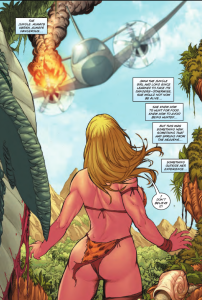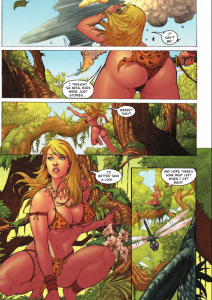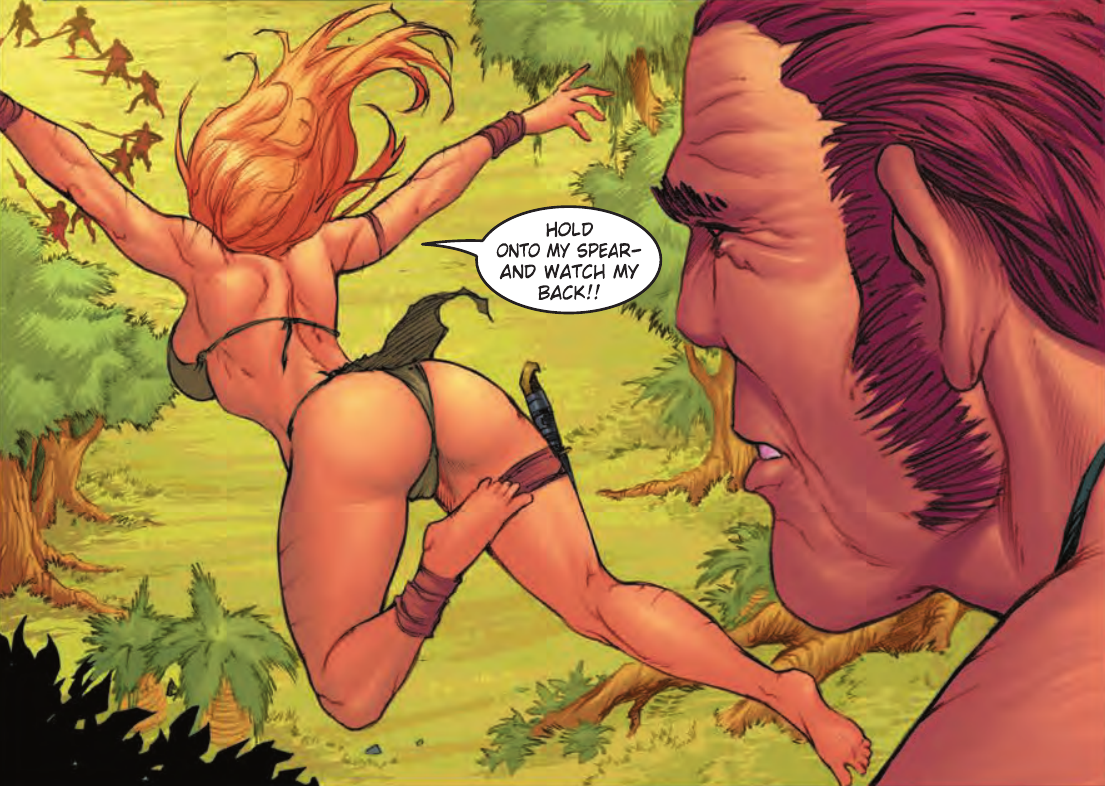The most important thing you need to know about this title is that it is pure, unadulterated pulp. It is cheesy in a throw-back sort of way and it celebrates that. I’ve been getting a lot of pulp and neo-pulp from Dynamite for some time now. For the time being, they seem to be the undisputed masters of the revival in pulp comics. Jungle Girl is an older pulp than the one that gave us Batman, The Shadow, and detective stories. Jana, the eponymous jungle girl, traces a direct line back to Tarzan, which, if Wikipedia is being accurate today, came out in 1912. It also mixes in a bit of The Land Time Forgot which, like Tarzan, was written by Edgar Rice Burroughs. So the story is almost one giant tribute to Burroughs’ legacy.
I have not read the source material so I’m unsure of how much Cho is also making tribute in the format of the story, but there is not so much a plot as a constant propulsion of our protagonists from one scene to the next. In one sense it’s nice not to have a McGuffin. Too often they are too transparently simply a means to start the plot and, as the linked TV Tropes page defines it, could be replaced by almost anything else. Still, the only driving force of this story is to constantly run away from trouble. They literally stumble around from one dino attack to another and then to the territory of rivals. The antagonist of the second series is seemingly found just as randomly.

While there’s no real plot to speak of, there is a topic to discuss that falls within the framework of this site: the character of Jana. From the very first panel in which we see Jana within this omnibus and, more egregiously the first two pages of the first issue, her portrayal is pure cheesecake. I’m of the opinion that there is nothing inherently wrong with cheesecake (or beefcake, the male counterpart). The reason cheesecake gets so much negative attention these days is that is is both omnipresent occurs out of proportion to the amount of beefcake. Despite the constant cheesecake shots, Jana is always in control of the situation. She is tough as nails and easily dispatches any male antagonists she comes up against. Jana even maintains the moral high ground in a late-story cat-fight with another female. Jana pulls her punches and tries to reason with the woman rather than be dragged into a petty fight. Although the fight is ostensibly picked over jealousy at Jana’s abilities and looks, it’s really because the woman is frustrated that her nefarious plans have gone awry.

Does Jana never being the damsel in distress make up for all the cheesecake? I’m not sure that’s the right question to ask, although I’m sure at least one person would surely be thinking it. After all, in the Superhero comics world, many of the women are subjected to cheesecake poses and they’re all powerful women in their own rights. At the same time, this book is a Tarzan book, meaning it’s in the jungle guy/girl genre and Togg could probably be considered beefcake in many of his shots.
While each person is certainly within their rights to seek out or avoid books based on their portrayal of women, I have to say that this book surprised me. I thought it was going to be more exploitative. While I didn’t enjoy the story for lack of plot, I did appreciate the fact that Jana was written so powerfully and that surpassed my expectations with respect to the costuming. It serves as a reminder that books can’t always be judged by their covers.
What do you think about the issue? I’d love to discuss anywhere you discover this writeup.
Jungle Girl Omnibus by Frank Cho and Doug Murray with art by Adriano Batista and colors by Frank Martin Jr and Giovani Kososki.
